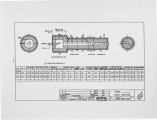| Title |
Low NOx Combustion with Natural Gas |
| Creator |
Neff, Glenn C. Sr.; Joshi, M. L.; Tester, Marvin E.; Panahi, Sherry K. |
| Publisher |
University of Utah |
| Date |
1990 |
| Spatial Coverage |
presented at San Francisco, California |
| Abstract |
An improved method of gas firing on a glass furnace and reduced NOx emissions is outlined. This method involves the use of a cracker for NOx reduction. The cracker method of gas firing takes about 25% of the furnace natural gas consumption through a separate cracker to produce soot particles. This is then re-blended with the balance of 75% of gas, producing a "soot-rich" gas mixture. The combustion of soot-rich gas produces flame with increased luminosity and lower adiabatic flame temperature characteristics which is expected to reduce NOx emissions by 35% or more. Past, current and future plans involving the cracker program are discussed. Past experiments on a pilot unit indicate a very low soot yield (-2%) due to undesirable reforming reactions. Current and future cracker design includes a new modulative gas cracker concept that incorporates several new features which enhance thermal cracking with very little reforming. |
| Type |
Text |
| Format |
application/pdf |
| Language |
eng |
| Rights |
This material may be protected by copyright. Permission required for use in any form. For further information please contact the American Flame Research Committee. |
| Conversion Specifications |
Original scanned with Canon EOS-1Ds Mark II, 16.7 megapixel digital camera and saved as 400 ppi uncompressed TIFF, 16 bit depth. |
| Scanning Technician |
Cliodhna Davis |
| ARK |
ark:/87278/s6rv0r8n |
| Setname |
uu_afrc |
| ID |
6128 |
| Reference URL |
https://collections.lib.utah.edu/ark:/87278/s6rv0r8n |
















